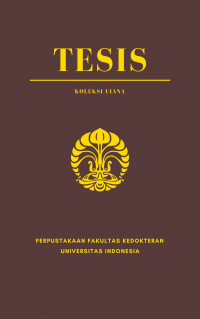Tesis
Efektivitas Low Level Laser Therapy pada Pasien Plantar Fasciitis dengan Obesitas = Effectivity of Low Level Laser Therapy in Plantar Fasciitis with Obesity.
Latar Belakang : Plantar fasciitis (PF) merupakan penyebab nyeri yang sering terjadi pada tumit. insidensi PF terjadi 2,9 kali lebih banyak pada pasien dengan obesitas. Tatalaksana PF non-operatif, salah satunya adalah dengan low level laser therapy (LLLT). Penelitian yang membuktikan bahwa satu terapi memiliki nilai lebih dibanding terapi yang lain masih sedikit. Tesis ini disusun untuk mengetahui efektivitas low level laser therapy (LLLT) dalam tatalaksana PF dengan obesitas. Metode : Penelitian ini menggunakan desain uji acak terkontrol dengan terapi standar yang terdiri dari latihan aerobik dan latihan peregangan serta penguatan fasia plantar, sebagai kontrol. Semua subjek penelitian (n=14), yaitu 7 orang pada kelompok perlakuan, dan 7 orang pada kelompok kontrol. Subjek penelitian adalah pasien yang telah didiagnosis PF dengan obesitas, unilateral PF, indeks masa tubuh (IMT) ≥ 25, nyeri tumit dengan visual analogue scale (VAS) 4 – 7, nyeri > 3minggu, dengan bukti tidak ada trauma akut usia 30-60 tahun, Moca ina normal ≥26, dan bersedia berpartisipasi dalam penelitian ini dan telah menandatangani lembar persetujuan penelitian (informed consent) setelah mendapat penjelasan. Pada awal penelitian dilakukan pemeriksaan ketebalan fasia plantar dengan menggunakan ultrasonografi (USG), pengisian foot and ankle outcome score (FAOS), dan nilai VAS. Kelompok perlakuan mendapatkan terapi LLLT dan terapi standar. Pemberian LLLT dengan dosis 8 J/cm 2 pada 4 area yaitu pada titik paling nyeri, area origo medial kalkaneus, fasia medial, dan regio insersi pada proksimal falang. Laser diberikan dengan teknik grinding. Kelompok kontrol mendapatkan terapi standar saja. Intervensi diberikan sebanyak 3 kali dalam seminggu, selama 4 minggu. Nilai VAS dievaluasi setiap akhir minggu. Evaluasi nilai FAOS dan ketebalan fasia plantar dilakukan kembali setelah intervensi selesai. Hasil : Penurunan nilai VAS secara signifikan bermakna pada kedua kelompok (p 0,04). Perubahan ketebalan fasia plantar secara statistik berbeda bermakna antara kedua kelompok ( p 0,01) . Nilai FAOS pada kategori nyeri menurun secara statistik bermakna (p 0,005). Simpulan : Pemberian LLLT selama 4 minggu, efektif menurunkan nilai VAS, ketebalan fasia plantar, dan FAOS kategori nyeri pada pasien PF dengan obesitas.
Kata kunci : Plantar Fasciitis, Obesitas, FAOS, VAS, Ketebalan plantar fascia.
Background: Plantar fasciitis (PF) is a common cause of pain in the heel. PF incidence occurs 2.9 times more in patients with obesity. Non-operative PF management, one of which is with low level laser therapy (LLLT). Research that proves that one therapy has more value than the other therapy is still a little. This thesis was aimed to determine the effectiveness of low level laser therapy (LLLT) in the management of PF with obesity. Method: The study used a randomized controlled trial design with standard therapies consisting of aerobic exercise, stretching and strengthening exercise of plantar fascia, as control. All study subjects (n=14), 7 people in the treatment group, and 7 people in the control group. The subjects of the study were patients who had been diagnosed with PF with obesity, unilateral PF, body age index (BMI) ≥ 25, heel pain with visual analogue scale (VAS) 4 – 7, pain > 3weeks, with evidence of no acute trauma aged 30-60 years, Moca ina normal ≥26, and willing to participate in this study and have signed a research approval sheet (informed consent) after being briefed. At the beginning of the study, plantar fascia thickness examination was conducted using ultrasound (USG), foot and ankle outcome score (FAOS), and VAS. Treatment groups get LLLT therapy and standard therapy. Administration of LLLT at a dose of 8 J /cm 2 in 4 areas, namely at the most painful point, the area of origo medial calcaneus, medial fascia, and regio insertion in the phalang proximal. Lasers are provided with grinding techniques. The control group gets standard therapy only. Intervention is given 3 times a week, for 4 weeks. VAS values are evaluated at the end of each week. Evaluation of FAOS values and plantar fascia thickness is performed again after the intervention is completed. Result: The decrease in VAS values was significantly significant in both groups (p 0.04). Changes in plantar fascia thickness are statistically different significantly between the two groups ( p 0.01) . FAOS values in the pain category decreased statistically significant (p 0.005). Conclusion: Administration of LLLT for 4 weeks, effectively lowering VAS, plantar fascia thickness, and FAOS pain category in PF patients with obesity.
Keywords : Plantar Fasciitis, Obesity, FAOS, VAS, Plantar fascia thickness
- Judul Seri
-
-
- Tahun Terbit
-
2021
- Pengarang
-
Astri Kusuma Dewi - Nama Orang
Dewi Friska - Nama Orang
Tirza Z. Tamin - Nama Orang
Nyoman Murdana - Nama Orang - No. Panggil
-
T21229fk
- Penerbit
- Jakarta : Program Studi Kedokteran Fisik dan Rehabilitasi., 2021
- Deskripsi Fisik
-
xiv, 109 hal; ill; 21 x 30 cm
- Bahasa
-
Indonesia
- ISBN/ISSN
-
-
- Klasifikasi
-
NONE
- Edisi
-
-
- Subjek
- Info Detail Spesifik
-
Tanpa Hardcopy
| T21229fk | T21229fk | Perpustakaan FKUI | Tersedia |


Masuk ke area anggota untuk memberikan review tentang koleksi